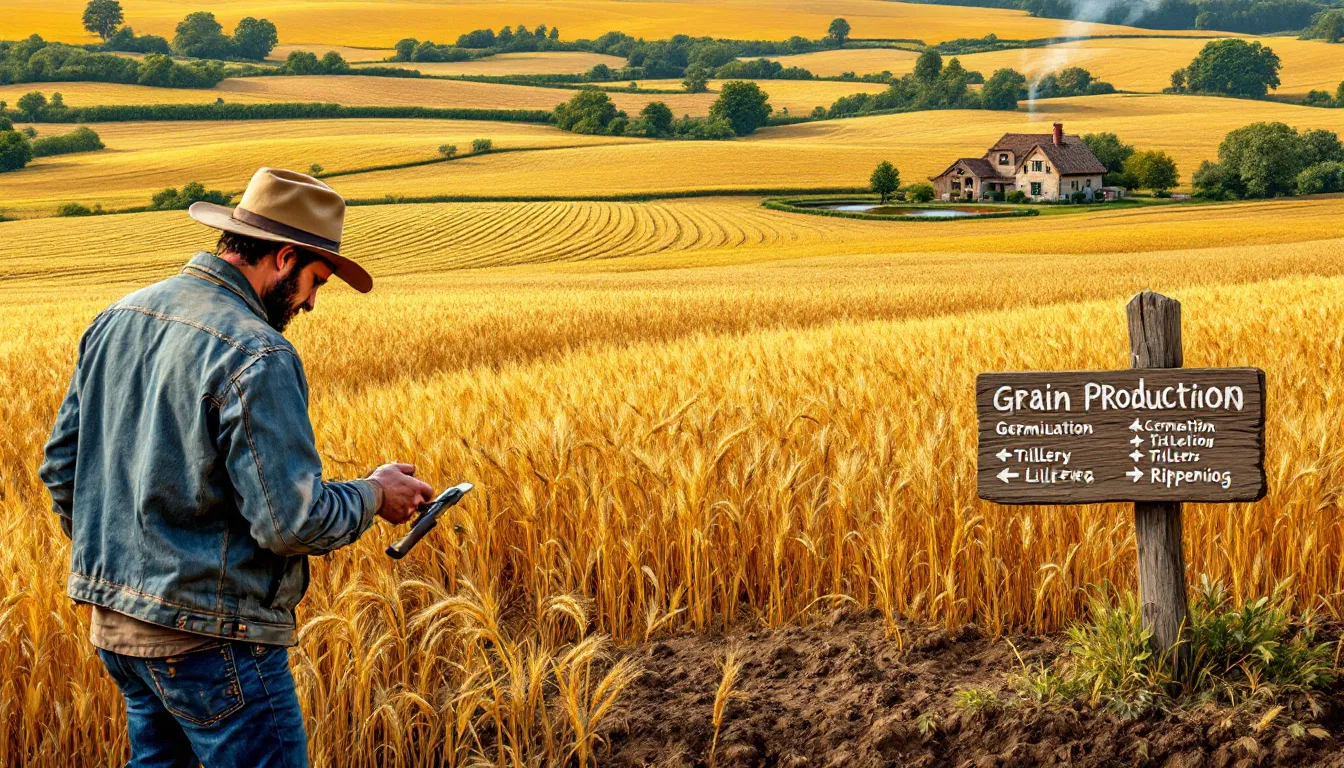
Grain production remains a cornerstone of agriculture in the United States, providing essential staple foods for human consumption and animal feed. With climate, soil type, and growing seasons varying widely across states, the selection of grain combinations tailored to specific regions is key to improving grain yield, soil health, and crop sustainability. In this article, we dive deep into how different grains, from whole grains to ancient grains, thrive in specific regions, and what best practices farmers can use to optimize production.
Introduction to Grain Production
Grain production is the process of cultivating members of the grass family, including wheat, barley, corn, oats, rice, and sorghum. These crops are vital due to their role in providing carbohydrates, fiber, and protein for billions of people. As climate conditions and agricultural capacities differ across states, understanding region-specific grain combinations is essential.
Key elements in successful grain production include:
-
Choosing the right wheat varieties and grain flour types for local conditions
-
Incorporating crop rotations to manage pests and improve soil fertility
-
Timing planting dates correctly to avoid fungal pathogens
A focus on sustainable agriculture practices can help reduce inputs like fertilizer and water, benefiting both yields and the environment.
Understanding Whole Grain Benefits
Whole grains retain the bran, germ, and endosperm, offering higher protein content, more fiber, and essential nutrients compared to refined grains. Popular types of whole grain flour include:
-
Whole wheat flour: Rich in B vitamins and fiber
-
Barley flour: Contains beta-glucans which help lower cholesterol
-
Oat flour: Great for heart health
The stone milling process helps preserve nutrients during processing, ensuring a healthier flour. Regular consumption of whole grains is linked to reduced risks of:
-
Type 2 diabetes
-
Cardiovascular disease
-
Obesity
According to Harvard T.H. Chan School of Public Health, replacing refined grains with whole grains significantly improves long-term health outcomes.
Ancient Grains and Their Uses
Ancient grains like spelt, triticale, and emmer have not been genetically modified or altered extensively. They are known for their unique flavor, weaker gluten, and higher nutrient density.
Popular ancient grains:
-
Spelt: Nutty flavor, good for bread and pasta
-
Triticale: Hybrid of wheat and rye, used in baked goods and cereals
-
Farro: High in iron and magnesium, great in soups and salads
Because of their weaker gluten, ancient grains are ideal for those with mild gluten sensitivities. However, they are not gluten free. Ancient grains are often used in artisanal baking due to their complex flavors and health benefits.
Small Grains and Their Role in Grain Production
Small grains—such as wheat, barley, oats, and rye—are central to grain production. Their versatility supports both human consumption and animal feed industries.
Factors that impact small grain success include:
-
Seeding rate and planting depth
-
Planting date (early spring or fall for cool-season grains)
-
Foliar disease resistance
Rotating small grains with warm season crops like soybeans or corn helps improve seed germination rates and reduces weed pressure.
Corn Flour and Its Applications
Corn flour is a finely ground powder made from dried corn, commonly used in:
-
Tortillas and tamales
-
Baked goods and breakfast cereals
-
Thickening agents for soups and sauces
Rich in carbohydrates, corn flour is naturally gluten free and widely used across Southern states. Nixtamalization, a traditional process used in Latin America, improves the nutritional profile of corn-based products by making niacin more bioavailable.
Planting Dates and Schedules
Planting at the correct time can significantly impact crop success. For example:
-
Wheat grown in Kansas is typically planted in early fall
-
Corn in Iowa is planted in late April to early May
Benefits of strategic planting:
-
Reduced incidence of fungal pathogens
-
Better use of moist soil for seed germination
-
Longer growing season for warm-weather crops
Refer to your local cooperative extension office for region-specific guidelines.
Seeding Rate and Calibration
Proper seeding rate ensures optimal plant density, improving harvested grain quality. Over-seeding can cause:
-
Increased weed competition
-
Reduced airflow and higher disease risk
Use of precision equipment like calibrated seed drills improves planting accuracy.
Tip: Always perform a soil test before seeding to determine nutrient needs and avoid over-application of fertilizers.
Weed Management Strategies
Effective weed control protects yields and maintains soil structure. Options include:
-
Crop rotations to break weed life cycles
-
Cover crops (e.g., clover or radish) to suppress weeds
-
Mechanical cultivation and mulching
According to SARE (Sustainable Agriculture Research and Education), integrated weed management lowers herbicide dependence and improves soil biodiversity.
Pest Management: Hessian Fly Control

The Hessian fly targets wheat and other small grains, laying eggs in young plants. The larvae feed on the plant base, causing stunted growth and poor grain development.
Control strategies:
-
Use resistant wheat varieties
-
Adjust planting dates to avoid peak infestation
-
Integrate biological control methods (e.g., parasitoid wasps)
Case Study: Kentucky farmers reduced Hessian fly problems by 40% after shifting planting by two weeks and using resistant seed.
Regional Grain Combination Examples
Northern Great Plains:
-
Wheat, barley, and oats dominate due to cooler climates
-
Shorter growing seasons favor quick-maturing grains
Midwest:
-
Corn, soybeans, and soft red winter wheat thrive
-
Rich soil supports intensive cropping systems
South:
-
Corn, sorghum, and rice are popular
-
Long growing seasons support double cropping
West Coast:
-
Hard white wheat, triticale, and barley are common
-
Drought-resistant varieties are essential due to limited rainfall
Grain Production Challenges and Opportunities
Challenges:
-
Climate change affects planting schedules
-
Soil erosion from monoculture practices
-
Limited access to new equipment for small farms
Opportunities:
-
Use of no-till farming and cover crops
-
Development of disease-resistant varieties
-
Expansion of organic and specialty grain markets
According to USDA, farms using conservation tillage report 20–30% higher soil organic matter over a decade.
Best Practices for Grain Production
To maximize grain yield and maintain soil integrity, adopt the following:
-
Diverse crop rotations to reduce pest and weed pressure
-
Use soil health management tools like compost and biochar
-
Select resistant crop varieties suited for your region
-
Implement integrated pest management (IPM) systems
-
Preserve wetlands and buffer strips to prevent runoff
Local farms that adopt these practices see improved plant health, reduced inputs, and stronger community food systems.
Conclusion and Future Outlook

Grain production is more than just planting and harvesting. It involves a deep understanding of regional climates, soil conditions, and crop behavior. Whole wheat, ancient grains, and small grains each play a role in building resilient farming systems.
With a focus on region specific grain combinations: what works best in your state, farmers can:
-
Enhance productivity
-
Promote soil conservation
-
Improve nutritional outcomes for consumers
Future innovations should aim to reduce carbon dioxide emissions, minimize waste, and increase access to sustainable, nutritious grain products.
For more tools and guides, visit:
Explore more from our blog:

Good https://shorturl.at/2breu
Good https://shorturl.at/2breu
Good https://lc.cx/xjXBQT
Good https://lc.cx/xjXBQT
Awesome https://rb.gy/4gq2o4
Very good https://rb.gy/4gq2o4
Awesome https://is.gd/N1ikS2
Awesome https://is.gd/N1ikS2
Good https://is.gd/N1ikS2
Good https://is.gd/N1ikS2